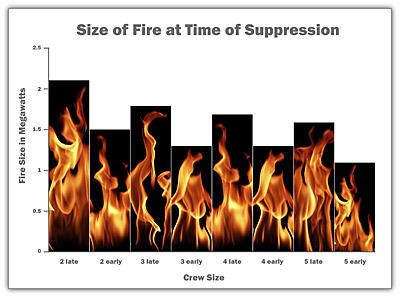
Researchers from the National Institute of Standards and Technology (NIST) and the International Association of Fire Fighters have prepared an educational resource for fire chiefs, firefighters, and public officials to summarize and explain the key results of a landmark study on the effect of the size of firefighting crews on the ability of the fire service to protect lives and property in residential fires.
The study, Report on Residential Fireground Field Experiments, was published by NIST last April. The study is the first to quantify the effects of crew sizes and arrival times on the fire service's lifesaving and firefighting operations for residential fires. Little scientific data on the topic had been previously available. The research demonstrated that four-person firefighting crews were able to complete 22 essential firefighting and rescue tasks in a typical residential structure 30 percent faster than two-person crews and 25 percent faster than three-person crews. (More information on the study is available online.)
"The results from this rigorous scientific study on the most common and deadly fire scenarios in the country—those in single-family residences—provide quantitative data to fire chiefs and public officials responsible for determining safe staffing levels, station locations and appropriate funding for community and firefighter safety," says NIST's Jason Averill, one of the study's principal investigators.
The educational toolkit was developed to provide policymakers with a quantitative and qualitative understanding of the research. The toolkit was funded by the Federal Emergency Management Agency's Assistance to Firefighters (FIRE Act) grant program. The toolkit contains a bound copy of the report, a brochure of the executive summary for use in public meetings, a DVD with side-by-side video comparing the timing of various tasks for different crew sizes, fact sheets on key findings, time-to-task results, and results on the effect of crew size on the time to apply water on a fire, the fire growth rate, and occupant exposure to toxins. A press release describing the study, stakeholder quotes, and public statements by principal investigators are also included in the toolkit.
The toolkit may be requested by sending email to shildebrant [at] iaff.org (shildebrant[at]iaff[dot]org) or jason.averill [at] nist.gov (jason[dot]averill[at]nist[dot]gov). The partner organizations contributing to this study— the International Association of Fire Chiefs, the Commission on Fire Accreditation International, and Worcester Polytechnic Institute—also will make the toolkits available.
The Report on Residential Fireground Field Experiments, NIST Technical Note 1661, can be downloaded at: (http://www.nist.gov/manuscript-publication-search.cfm?pub_id=904607).

